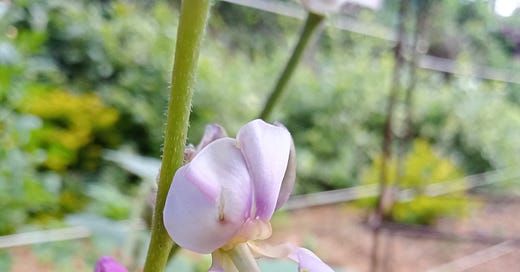Njahi has pretty flowers, ranging from pale pink to lavender. It vines tenaciously, clinging to whatever support exists. I keep trying to train it, but it resists my direction, leaping through the air waywardly. It’s a perennial bean, perhaps even an eternal bean. Once planted, it stays planted. It survives floods and droughts, always ready to vine and flower and pod.
Njahi is considered one of the few indigenous Kenyan beans.
In Kikuyu tradition, njahi, mashed with sweet bananas, is given to new mothers. Protein for healing. Sweet bananas for sweetness. It might be that this particular bean is given in the hope that its qualities—beauty, waywardness, toughness, relation—imbue the new mother and child with those qualities. A climbing bean is always a bean that privileges relation. It holds on, twists around, entangles, relies on. It models how we are entangled with and interdependent on each other.
When I was a child, I liked the mashed njahi, probably because of how the sweet bananas changed the taste and texture.
Njahi beans are pretty, black with a white, ridged edge.
Njahi is an acquired taste. The beans do not soften completely. The skin stays slightly tough. I suspect someone with patience could de-skin the beans. I am not that patient. Even with the skins removed, the inside flesh remains slightly gritty. Unlike pinto beans or rosecoco, njahi never becomes silky smooth. I once made the mistake of trying to make njahi soup using an immersion blender. The blender broke.
That might be hyperbole.
Njahi holds stories.
British colonizers did not like njahi. They could not figure out how to make it profitable. It was an acquired taste. So they introduced different varieties of annual beans that could be marketed more successfully and cooked faster. Annual beans that grew faster. Yet, those beans were also more subject to the disruptions of colonialism. Unlike njahi, those beans could not survive drought. They could not survive being abandoned. They needed constant tending. These were not beans that carried memories. These were not wayward beans, though they might twine and vine and entangle. They were more fragile. More subject to the disruptions of colonialism.
Njahi remembers.
An auntie tells me that njahi sustained them during the ruptures of colonialism, during forced villagisation, during those disrupted days and terrifying nights full of colonial brutality. The tenacious bean grew and twined and entangled, weaving in and out of freedom dreams. The persistent bean flowered and podded, adding beauty to make freedom feel more possible, beauty to sweeten those bitter days.
The tough bean could be left to cook all day and would still have integrity—shape, texture—when people returned from forced labor. As it twined and entangled and survived and retained its integrity, njahi modeled how to be in relation.
Despite all this. Knowing all this. Feeling much of this. I dislike njahi.
An auntie tells me I would have starved during the emergency because I do not eat njahi. And I think about how quotidian food—njahi was the Kikuyu bean before colonialism—turns into survival food, but is sweetened by that earlier memory. And how, after the years of survival eating, the food is still eaten with reverence. A food from before the bad. A food eaten during the bad. A food that sits between and across time. A food that holds up. A food that twines and entangles, holding celebration and survival.
Njahi insists on itself. Other beans can be infused with cumin and coriander and black pepper and turmeric; they play well as background notes to other foods; they rejoice in being accompaniments to meat dishes. Njahi refuses all of this. Unlike beans that will have you asking what they are—is this pinto or rosecoco—njahi announces itself loudly. It dries out your mouth and scratches your throat. It moves at its own pace.
And it never, never softens, no matter how long you cook it.
I like my beans to yield and pulp. To blend into soup or meld into rice. There might be firmness, but it melts once you bite into it.
Perhaps njahi holds on to too many stories. Perhaps it has seen too much. Survived too much. I have tried to uproot it several times, but a seed always survives. The plant springs back tenaciously. These days, I grow it for the flowers. Bumblebees love it.






Loved this. The bean that refuses to yield! I wonder if Njahi would soften in a pressure cooker or would resist that too?